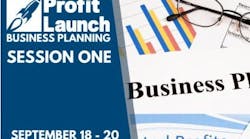One of the questions I often get from contractors is, “When should I grow my business?’”
My answer is always the same, “When you have learned to make money on your existing business.”
After years of working with thousands of contractors I have learned that if you can’t make money at $1,000,000 in annual revenue you won’t make money at $2,000,000 in annual revenue.
Learning how to turn a profit is a very different skill than growing revenue, so until you learn to turn a profit on your current revenue, it doesn’t matter how much revenue you generate. You can easily double revenue and brain damage without generating profits.
It reminds me of the old story of a contractor who was losing money on every installation, but decided he could make up for it by doing more installations. We’ll make it up in volume! Or the contractor whose response to losing money on every service truck was to put more trucks on the road!
Again, making a profit is very different form generating revenue. Anyone can open a company and generate revenue. It takes a savvy business expert to turn a profit.
Since the beginning of time there are only two ways to grow your business. You can grow your business buy attracting new customers or you can grow your business by solving additional problems for your existing customers.
Growing your business by attracting new customers can be very expensive and often the results are less than ideal. For example, let’s say a company has 500 sales opportunities each year and wants to double revenue by generating 500 additional sales leads. Doing that requires time and a ton of marketing money to generate the 500 additional sales leads.
Once the company has spent the time and money to generate 500 new leads, guess what happens next? The company has to hire new sales staff, installers and technicians and purchase new vehicles to service the new customers. With new sales staff, installers, technicians and vehicles come additional labor expenses, insurance, fuel and worker’s compensation and other increases in overhead.
New office staff and CSRs are needed to support the new sales staff. Plus, installers and technicians are needed, which adds additional overhead. Then more office space is needed to house the new office staff. You get the picture?
In many cases, the increased revenue generated with new customers is consumed by additional expenses, leaving us with a company that is twice the size and twice the brain damage, but no more profitable than it was at half the size.
Sounds wonderful, doesn't it? Maybe with a little luck, we’ll even get to work more hours to run a company twice as big as it was, yet no more profitable.
As unattractive as this scenario appears to be, I have seen it countless times. A company that is not profitable grows its revenues, increases brain damage and requires more time to manage, but remains as unprofitable as ever.
Let’s look at the second way of growing this company. Let’s imagine that this company chooses to double its revenue by improving sales skills and solving additional problems on its existing 500 sales opportunities, and thereby growing revenues without the expense of generating 500 new sales leads
We will assume that the existing sales productivity of the company looks something like this:
Leads per year: 500
Total number of sales (40 percent): 200
Average dollar volume per sale: $5000
Total Revenue $1,000,000
Now instead of trying to double revenue by generating 500 new sales leads, the company chooses to double revenue by increasing sales productivity. In other words, this company chooses to double revenue by getting better at selling and solving more problems on their existing 500 sales opportunities.
So the company learns to get better at selling. After all, since they were closing four sales out of every 10 leads, that means they were losing six sales out of every 10 leads. The net result is that after learning to implement a professional sales system, they manage to close one of the six sales leads they were previously losing, thereby improving sales productivity to 50 percent from the previous 40 percent.
Additionally, the company learns how to engage in a more comprehensive discovery process, which results in identifying more problems, which the company learns to solve for its homeowners. The net result of that effort is that they company solves more high efficiency, indoor comfort and air flow problems.
This results in increasing the average sale from $5,000 to $8,000. The increase in average sale does not come from high pressure sales or arbitrary price increases. The increase in average sales is a result of solving comprehensive home comfort and efficiency problems.
The combination of those two efforts results in sales productivity that looks like this:
Leads per year: 500
Total number of sales (50%): 250
Average dollar volume per sale: $8,000
Total Revenue: $2,000,000
How much did overhead increase by doubling revenue through this method? How much additional marketing expense did they incur? Absolutely $0. Of course there will be an increase in Cost of Goods as the company sells more systems and more comprehensive home comfort solutions.
But because the company doubles revenues without the corresponding increases in expenses, profitability soars. Now the company is ready to commit the resources to attract new customers, because they have learned to be profitable on their existing customers.
If you are considering growing your company, you must make sure you grow it in a way that generates additional profits, not just additional brain damage and expenses.
To make sure this happens, it’s critical to make sure that your company is generating maximum sales productivity on the existing sales opportunities and that your company is profitable. Once you’ve got generating a profit out of your existing revenue, you’ll be perfectly positioned to grow your company and profitability.
Weldon Long is one of the EGIA Contractor University faculty members. EGIA Contractor University has assembled the most experienced and dynamic faculty ever put together. Faculty members have personally built some of the most successful contracting companies in America. Visit Contracting Business for more information and to learn about the Contractor Leadership Live event. Mr. Long’s online HVAC Sales Training is exclusively distributed by www.EGIA.org.
Weldon Long is the author of the New York Times and Wall Street Journal bestseller, The Power of Consistency. He is one of the nation’s leading experts in the field of improving mindset and sales productivity. His clients include Direct Energy, Fed Ex, The Home Depot, Comcast, Carrier Corporation, Goodman Manufacturing, Mitsubishi Electric, Rheem Manufacturing and many of the most successful HVAC and Plumbing contractors in America. Mr. Long’s work and books have been endorsed by Dr. Stephen R. Covey, Tom Hopkins, Tony Robbins, Mark Victor Hanson and the Napoleon Hill Foundation. Learn more at www.WeldonLong.com.










